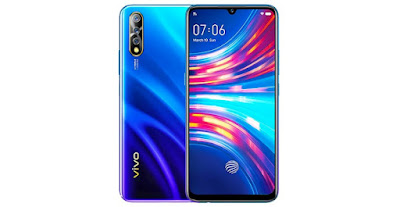Vivo S1 Review: The 'Clear' is Fun for Photos and Durable
Tuesday, July 23, 2019
Edit
Vivo S1 comes with an impressive screen, triple camera, and jumbo battery. Check out reviews of strengths and weaknesses, and complete specifications!
The advantages and disadvantages of Vivo S1
Review Vivo S1 - Present not only to enliven competition in the mid-range segment, Vivo S1 really wants to be the best. Beautiful and clear design, three main cameras, a mainstay kitchen, and large capacity batteries can be more than enough supporters to make it happen.
Not only that, the Vivo S1 is also equipped with current features, such as virtual assistants with artificial intelligence, the latest fingerprint sensors, and extensive capacity internal memory. What's more, the current design makes this handphone a target for young people.
If, is this smartphone worth having? To get a conclusion, first consider the advantages and disadvantages, as well as the full specifications of the following Vivo S1!
Vivo S1 Full Specifications
- Name: Vivo S1
- Release: July 2019
- Weight: 179 grams (g)
- Screen Type and Size: 6.38 inches Super AMOLED
- Screen Resolution: Full HD + 2,340 x 1,080 pixels
- Chipset: MediaTek Helio P65 (12 nm)
- Processor: Octa core (2 × 2.0 GHz Cortex-A75 + 6 × 1.7 GHz Cortex-A55)
- RAM: 4GB
- Internal Memory: 128GB
- External Memory: microSD card up to 256 GB
- Rear Camera: 16 MP (Sony IMX499 sensor, f / 1.78) + 8 MP (f / 2.2, super wide angle lens) + 2 MP (depth sensor)
- Front Camera: 32 MP (f / 2.0)
- Bluetooth: Version 5.0
- USB: microUSB 2.0
- Sensor: Fingerprint (on screen), accelerometer, ambient light, proximity,e-compass, virtual gyroscope
- Battery: 4,500 mAh with Dual-Engine Fast Charging 18 W
- Price: IDR 3.6 million (check the complete Vivo S1 price)
The advantages of Vivo S1
1.'Clear' screen with Super AMOLED
Vivo S1 is equipped with a 'AMOLED' Super AMOLED type screen. provides maximum brightness even when exposed to sunlight. In addition, this type of screen is also very efficient in consuming power.
Another advantage of the Super AMOLED screen is that the device is able to have an always-on display feature. Where there are animated images or notifications even though the cellphone is locked and the screen is off.
2.Three Rear Cameras
Although there are now many cellphones that come with three main cameras, this feature remains special for the middle class. The third combination of the camera is quite powerful, with a 16 MP configuration (wide lens, PDAF), plus 8 MP (ultrawide lens) and 2 MP for the bokeh effect.
Plus, the main lens of the Vivo S1 camera is known to use the Sony IMX 499 camera sensor. So, it is fairly satisfying to be relied upon to take exciting photos.
3.Selfie Camera Mainstay
The Vivo party is targeting young users, deliberately providing a high resolution selfie camera, which is 32 MP at S1. Vivo itself is known to have a satisfactory track record for the front camera business, especially before they were very focused on this.
In addition to quality, the front camera is also equipped with a variety of features, such as AI Face Beauty, AI Selfie Lighting, AR Stickers, AI Filters, and other features to provide a more enjoyable photo experience.
4. Fingerprint Sensor on the Screen
Regarding security, Vivo provides S1 with fingerprint sensor technology behind the screen that is embedded in the smartphone of today's flags. Vivo calls it Screen Touch ID. This feature makes the rear body design look clean and neat.
5. Special Keys for Job Access
Just like the features that are owned by Samsung, Vivo S1 is also equipped with a digital assistant button on the device. With this button, users can activate Jovi Wisdom to identify maps, activate voice commands, and other practical functions.
As is known, like Samsung's Bixby, Jovi is an artificial intelligence-based virtual assistant developed by Vivo.
6. Chipsets are quite tough
Vivo S1 is equipped with a fairly strong chipset from MediaTek, namely Helio P65. This processor has eight processing cores (octa core) with a blend of ARM Cortex-A75 and Cortex-A55 architectures with speeds of up to 2.0 gigahertz (GHz).
Besides being reliable, the 'brain' is also efficient because it has used 12 nanometer (nm) fabrication technology. So, power consumption is quite economical.
7. Jumbo Battery with Dual-Engine Fast Charging
Behind its elegant appearance, the S1 carries an above-average capacity of 4,500 mAh. This large battery is combined with a power-saving processor, which will certainly make it easy to last a full day.
Moreover, supported by fast charging technology called Dual-Engine Fast Charging with 18 Watt (W) power. The process of recharging the battery can be done briefly.
The disadvantages of Vivo S1
Although entering the middle segment, unfortunately the Vivo S1 is not equipped with USB Type-C and instead carries microUSB 2.0. This is considered 'lagging', because microUSB is badly defeated in matters of data transfer, power accommodation, and other uses.
9. Does not support NFC
Near Field Communication (NFC) is a technology that is quite important in the digital era like now. One of its functions is to facilitate transactions with electronic money.
10. Bodily Vulnerable
Even though it has a cool design with beautiful color gradations, the Vivo S1 body is very dirty easily from finger tracing. So it is advisable to use a soft case or hard case to make it more hygienic.
